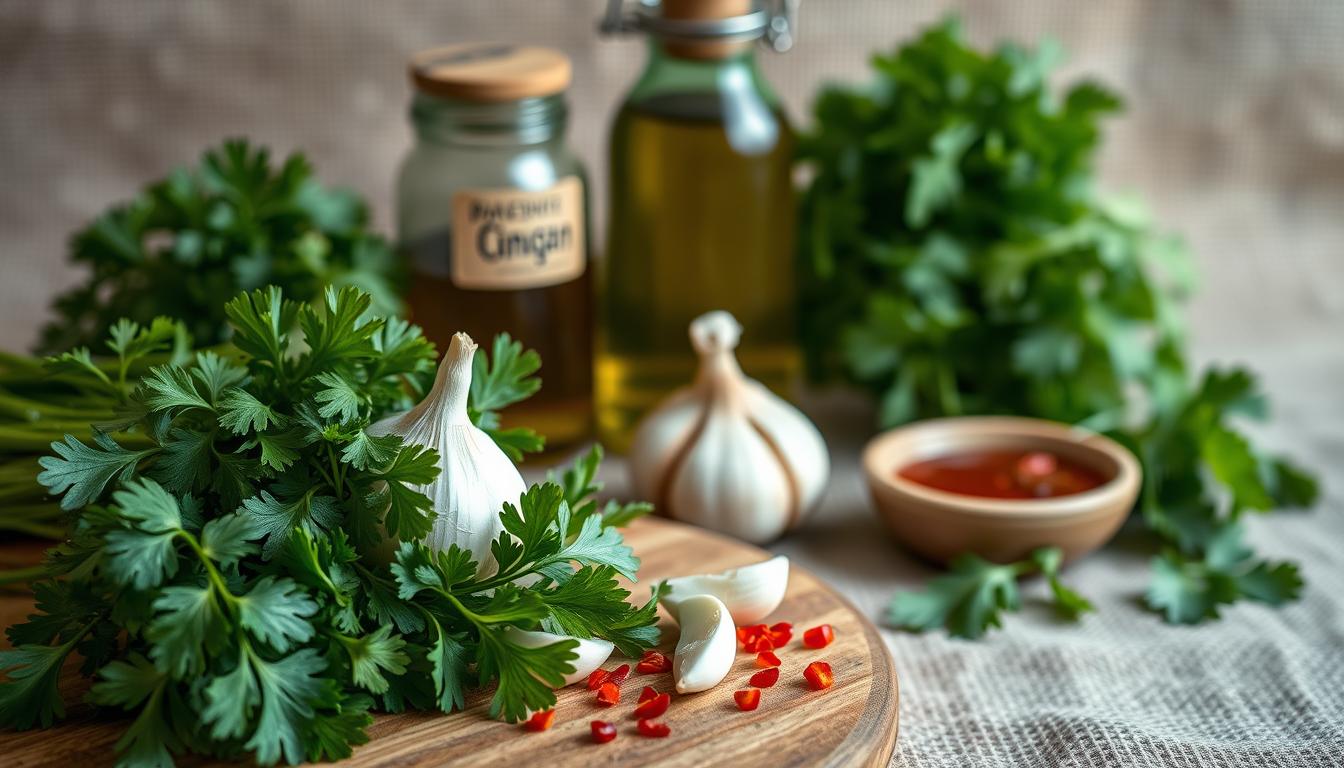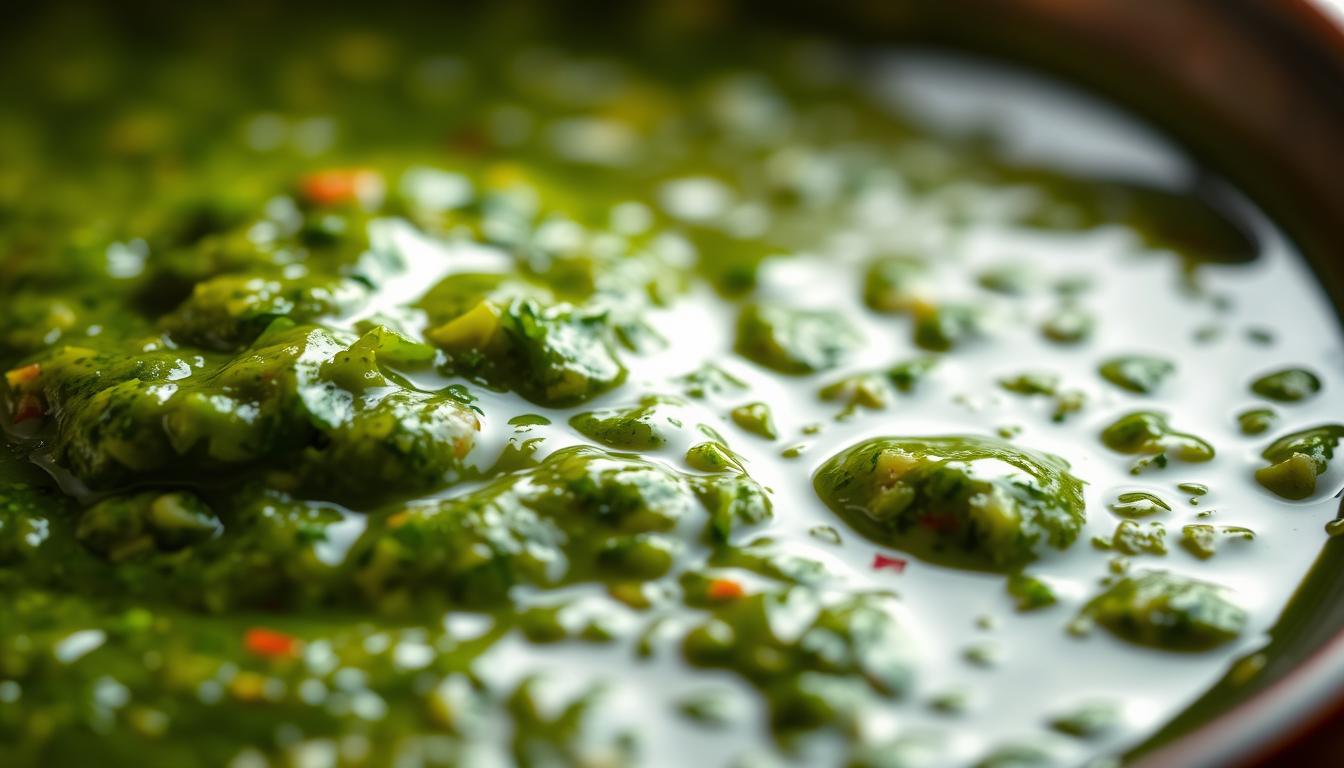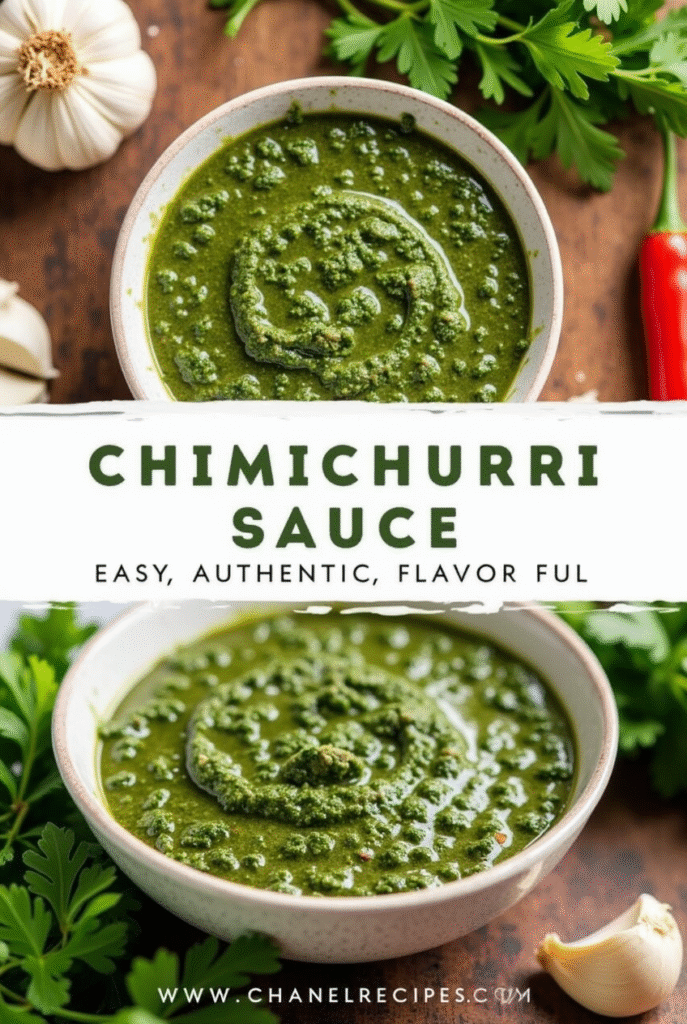Chimichurri Sauce
Imagine adding a burst of fresh flavor to your grilled meats, vegetables, and breads. You’re about to unlock the secret to a condiment that elevates your cooking: Chimichurri Sauce.
This Argentinean classic is made with simple ingredients, yet its impact on your dishes is profound. Whether you’re a seasoned chef or just starting to explore the world of flavors, learning how to make Chimichurri Sauce is a journey worth taking.
With this guide, you’ll not only learn the basics of making this delicious condiment but also discover its versatility and how it can become a staple in your kitchen.
What is Chimichurri Sauce?
Chimichurri sauce comes from Argentina and Uruguay. It’s a flavorful condiment that brightens up many dishes. Its green color comes from fresh herbs, vinegar, and spices. You can use it to marinate, dress, or top food, making it a great addition to your cooking.

Origins and Cultural Significance
Chimichurri sauce is a big part of Argentine and Uruguayan food. It’s often served with grilled meats, like asados. This sauce is a sign of the area’s rich culture, linked to outdoor meals and family times.
Making and sharing chimichurri is seen as a way to welcome guests and bring people together.
Traditional vs. Modern Variations
Traditional chimi churi recipes use parsley, oregano, garlic, red pepper, vinegar, and olive oil. But, modern recipes add new twists. Some chimmi churri sauce recipes include cilantro, lemon, or different peppers. This lets you try different flavors and find your favorite.
Essential Ingredients for Authentic Chimichurri Sauce
To make a real Chimichurri Sauce, you need a few key ingredients. These ingredients give the sauce its perfect taste. The quality of these ingredients is very important for the taste and freshness of your Chimichurri.
Fresh Herbs: Parsley and Oregano
Fresh parsley and oregano are the heart of Chimichurri Sauce. Parsley brings a fresh, green taste. Oregano adds a bit of bitterness and earthiness. Using both herbs gives the sauce a balanced flavor.
When picking parsley, look for bright green leaves that are not wilted. For oregano, choose fresh leaves that are vibrant in color. This ensures the best flavor.
Garlic and Red Pepper Flakes
Garlic and red pepper flakes are key for depth and heat in the sauce. Minced garlic adds a strong flavor that goes well with the herbs. Red pepper flakes give a subtle kick, making the flavor better.
You can adjust how spicy you want the sauce by changing the amount of red pepper flakes.
Oils, Vinegars, and Acids
Olive oil is the base of Chimichurri Sauce, bringing everything together. Red wine vinegar adds a tangy, acidic taste that balances the oil. This acidity also helps preserve the sauce and makes it taste better.

| Ingredient | Role in Chimichurri | Tips for Selection |
|---|---|---|
| Fresh Parsley | Adds fresh, green flavor | Choose bright green leaves |
| Oregano | Contributes earthy notes | Opt for vibrant, fresh leaves |
| Garlic | Infuses pungent flavor | Use minced garlic for best results |
| Red Pepper Flakes | Adds a touch of heat | Adjust according to desired spiciness |
| Olive Oil | Serves as the sauce base | Choose high-quality olive oil |
| Red Wine Vinegar | Adds tanginess and preserves sauce | Adjust ratio to taste |
By focusing on these essential ingredients and their roles, you can create an authentic and delicious Chimichurri Sauce to enhance your dishes.
Equipment You’ll Need
Before you start making your easy chimichurri sauce, it’s important to have the right tools. The way you prepare it can change its texture and taste.
Manual vs. Electric Preparation Methods
You can choose between manual or electric methods for making chimichurri sauce. Manual methods use a knife or mortar and pestle for a finer texture. Electric methods, like a food processor, are faster and better for big batches.
Storage Containers
After making your chimichurri sauce, you’ll need a good container to store it. Glass jars with tight lids are perfect for the fridge. Here’s a look at different storage options:
| Container Type | Refrigerator Life | Freezer Life |
|---|---|---|
| Glass Jar | Up to 1 week | Up to 6 months |
| Plastic Container | Up to 5 days | Up to 3 months |
Step-by-Step Guide to Making Chimichurri Sauce
Now that you have all the ingredients, let’s start making Chimichurri Sauce. This guide will help you prepare your ingredients, chop and mix the sauce, add liquids and seasonings, and let it rest.
Preparing Your Ingredients
Begin by rinsing the fresh parsley and oregano under cold water. This removes dirt or debris. Pat them dry with a paper towel to avoid excess moisture. Peel the garlic cloves and chop them roughly for blending. Measure the red pepper flakes for your desired spiciness.
Chopping and Mixing Technique
Put the chopped parsley, oregano, and garlic into a food processor or blender. Process until they’re well combined and finely chopped. Be careful not to over-process, as it can lose texture and flavor. If manual, finely chop and mix in a bowl.
Adding Liquids and Seasonings
Now, add the olive oil, red wine vinegar, and red pepper flakes (if using) to the herb mixture. Mix well to ensure everything is incorporated. Season with salt to taste, adjusting as needed to balance the flavors.
Resting Time and Why It Matters
Move the Chimichurri Sauce to a bowl or airtight container. Let it rest at room temperature for at least 30 minutes. This time allows the flavors to meld, improving taste and aroma. After resting, stir the sauce well before serving or storing.
Red Chimichurri vs. Green Chimichurri
The world of chimichurri is split into two groups. Some love the bright taste of green chimichurri. Others prefer the smoky heat of red chimichurri. This choice is based on the ingredients and flavors of each.
Ingredient Differences
Green chimichurri uses fresh parsley, oregano, garlic, red pepper flakes, red wine vinegar, and olive oil. Red chimichurri, on the other hand, has red pepper flakes and sometimes smoked paprika. These ingredients make red chimichurri spicy and smoky.
Flavor Profile Comparison
Green chimichurri tastes fresh and herbaceous with a tangy kick. Red chimichurri is bolder, spicier, and smokier. A chef says, “Red chimichurri adds a heat that boosts grilled meats and veggies.” Your choice depends on your taste and the dishes you want to improve.
Whether you like green or red, both are tasty ways to flavor your food. Trying both can lead to new favorite dishes.
Common Mistakes When Making Chimichurri Sauce
Making a great Chimichurri Sauce is easy, but some mistakes can ruin it. Knowing these errors helps you make a delicious and authentic sauce every time.
Over-Processing the Herbs
One big mistake is over-processing the herbs. Chopping or blending them too much can make them bitter and lose their color. To fix this, just chop them coarsely. This keeps their freshness and color in your Chimichurri Sauce.
Balancing Flavors
Getting the flavors right is also key. Your sauce should be tangy, salty, and herby. Don’t add too much garlic or red pepper flakes. Taste and adjust as you go to get the perfect balance.
Using Low-Quality Ingredients
Bad ingredients can ruin your sauce. Use fresh herbs, good olive oil, and proper vinegar. Avoid wilted herbs or low-grade oils. With the best ingredients, you’ll get a rich, vibrant Chimichurri Sauce that makes your meals better.
Creative Variations of Traditional Chimichurri Sauce
Want to mix things up with Chimichurri? Try new herb mixes and spice levels. The classic recipe is great, but you can also get creative.
Change up the herbs in Chimichurri for a new taste. For instance, swap parsley for cilantro to make a fresh, citrusy sauce. It’s perfect for fish or chicken.
Cilantro Chimichurri
Prefer cilantro over parsley? Make Cilantro Chimichurri. Just swap the parsley in your recipe for cilantro. A squeeze of lime juice adds extra flavor.
Spicy Chimichurri
Want some heat? Try Spicy Chimichurri. Add diced jalapeños or serrano peppers for a kick. Or, up the red pepper flakes for more spice.
Herb Substitutions and Additions
Play with different herbs to make unique Chimichurri. Add fresh dill, basil, or mint. Or, swap oregano for thyme or rosemary.
| Variation | Key Ingredients | Flavor Profile |
|---|---|---|
| Cilantro Chimichurri | Cilantro, lime juice | Fresh, citrusy |
| Spicy Chimichurri | Jalapeños, red pepper flakes | Spicy, bold |
| Dill Chimichurri | Fresh dill | Bright, refreshing |
Try new ingredients and flavors to make your own Chimichurri. It’s a great way to spice up your meals.
Nutritional Benefits of Chimichurri Sauce
Chimichurri sauce is a mix of herbs, vinegar, and oil. It’s good for your health when eaten with other foods. This sauce from Argentina adds flavor and nutrients to your meals.
Healthy Fats and Antioxidants
Chimichurri sauce has healthy fats from olive oil. Olive oil is good for your heart because it lowers bad cholesterol. The herbs in chimichurri, like parsley and oregano, also have antioxidants.
Antioxidants protect your cells from harm. They might lower the risk of heart disease and cancer.
Incorporating Chimichurri into a Balanced Diet
Chimichurri sauce is a better choice than high-calorie condiments. Use it to marinate meats or veggies, or as a salad topping. It’s easy to add nutrients to your meals with chimichurri.
Choose quality ingredients and watch your portions. This way, you can enjoy chimichurri’s health benefits while keeping your diet balanced.
Delicious Meals with Chimichurri Sauce
Chimichurri sauce is a versatile condiment that can elevate a variety of dishes. It adds flavor to grilled meats, seafood, and even vegetarian options. Let’s explore some delicious ways to use chimichurri sauce in your meals.
Classic Pairings with Grilled Steaks and Chicken
Chimichurri sauce is a classic choice for grilled steaks and chicken in Argentine and Uruguayan cuisine. Its tangy, herby flavor complements the charred, savory taste of grilled meats. Try it with grilled ribeye or flank steak, or as a marinade for chicken breasts before grilling.
Chimichurri with Fish and Seafood
Chimichurri sauce isn’t just for red meat; it’s great with fish and seafood too. Its bright, citrusy flavor pairs well with delicate fish like sole or tilapia. It also complements richer seafood like shrimp or scallops. Use it as a sauce for grilled salmon or as a dressing for seafood salads.
Vegetarian and Vegan Applications
Vegetarians and vegans can enjoy chimichurri sauce too. It’s a great addition to roasted or grilled vegetables. It can also be used as a dip for raw or roasted vegetable sticks. Plus, it’s a tasty sauce for vegan “meat” alternatives or as a topping for vegan burgers.
- Roasted vegetables with chimichurri sauce
- Grilled portobello mushrooms with chimichurri
- Vegan burgers topped with chimichurri sauce
Unexpected Uses: Sandwiches, Eggs, and More
Chimichurri sauce can also be used in unexpected ways. Try it as a spread on sandwiches, a topping for scrambled eggs or omelets, or as a dip for fries or breadsticks. The possibilities are endless, and it can add a burst of flavor to many dishes.
Storing and Preserving Your Chimichurri Sauce
Keeping your homemade chimichurri sauce fresh is key. Knowing how to store and preserve it is essential.
Refrigeration Guidelines
For short-term storage, refrigeration is best. Use an airtight container like a glass jar with a tight lid. This keeps air out and prevents spoilage.
- Store the sauce in the refrigerator at a temperature below 40°F (4°C).
- Keep the container away from light and heat sources.
- Stir the sauce well before using it, as ingredients may separate.
Your chimichurri sauce can last up to 1 week in the fridge. But for the best taste, use it within 3 to 4 days.
| Storage Method | Duration | Notes |
|---|---|---|
| Refrigeration | Up to 1 week | Use airtight container, keep away from light and heat |
Freezing Methods
Freezing is great for longer storage. It keeps your chimichurri sauce fresh and full of flavor. To freeze, put the sauce in an airtight container or freezer-safe bag. Make sure to remove air before sealing.
“Freezing is a great way to preserve the freshness of your chimichurri sauce. Simply thaw it in the refrigerator or at room temperature when you’re ready to use it.”
When you’re ready to use the frozen sauce, thaw it in the fridge or at room temperature. Stir well before serving. Frozen chimichurri sauce can last up to 6 months.
| Storage Method | Duration | Notes |
|---|---|---|
| Freezing | Up to 6 months | Use airtight container or freezer-safe bag, remove air before sealing |
Conclusion
Now you know how to make authentic Chimichurri Sauce. It’s rich in history and packed with health benefits. It’s set to become a favorite in your kitchen.
Creating a great Chimichurri Sauce means using fresh ingredients and finding the right balance of flavors. Whether you’re experienced in cooking or just starting, this sauce will make your dishes stand out. It adds a unique Argentinean touch to your meals.
Try out different versions of Chimichurri, like red or green. See how versatile it is, from topping grilled meats to adding flavor to veggies and sandwiches. With your new skills, you can explore endless possibilities in the kitchen. Your cooking will surely get more creative.
FAQ
What is Chimichurri Sauce?
Chimichurri Sauce is a tangy, herby condiment from Argentina and Uruguay. It’s made with fresh herbs, garlic, red pepper flakes, oils, vinegars, and acids.
How do I make Chimichurri Sauce?
To make Chimichurri Sauce, start by preparing your ingredients. Then, chop and mix the sauce. Add liquids and seasonings, and let it rest. You can use manual or electric methods.
What are the essential ingredients for authentic Chimichurri Sauce?
For authentic Chimichurri Sauce, you need fresh herbs like parsley and oregano. Also, garlic, red pepper flakes, oils, vinegars, and acids are key.
Can I customize Chimichurri Sauce to my taste?
Yes, you can customize Chimichurri Sauce. Try different herbs, spices, and ingredients. You can also make variations like Cilantro Chimichurri or Spicy Chimichurri.
How do I store Chimichurri Sauce?
To keep Chimichurri Sauce fresh, store it in the refrigerator or freezer. Follow proper guidelines for refrigeration or freezing to keep its flavor and quality.
What are some common mistakes when making Chimichurri Sauce?
Common mistakes include over-processing herbs, not balancing flavors, and using low-quality ingredients. Avoid these to make a delicious, authentic Chimichurri Sauce.
What are some delicious meals I can make with Chimichurri Sauce?
Use Chimichurri Sauce on grilled steaks and chicken, fish and seafood, and even as a topping for sandwiches and eggs. It’s versatile and delicious.
Is Chimichurri Sauce healthy?
Yes, Chimichurri Sauce is healthy. It’s full of healthy fats and antioxidants. Adding it to your meals can enhance flavor and nutrition.
Can I make Chimichurri Sauce ahead of time?
Yes, you can make Chimichurri Sauce ahead of time. Store it in the refrigerator or freezer. This way, you can plan ahead and have it ready when needed.
What’s the difference between red and green Chimichurri Sauce?
Red Chimichurri has red pepper flakes for a spicy flavor. Green Chimichurri is brighter and more herbaceous. They differ in ingredients and taste.
Did you like this recipe ?
There are no reviews yet. Be the first one to write one.

